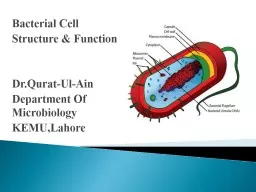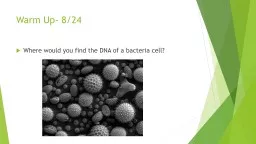PPT-Prokaryotes Biology What are Prokaryotes?
Author : calandra-battersby | Published Date : 2018-10-23
Singlecelled organisms Very tiny Cannot be seen without a microscope Our microscopes are not powerful enough Lack a nucleus and most other organelles Most numerous
Presentation Embed Code
Download Presentation
Download Presentation The PPT/PDF document "Prokaryotes Biology What are Prokaryotes..." is the property of its rightful owner. Permission is granted to download and print the materials on this website for personal, non-commercial use only, and to display it on your personal computer provided you do not modify the materials and that you retain all copyright notices contained in the materials. By downloading content from our website, you accept the terms of this agreement.
Prokaryotes Biology What are Prokaryotes?: Transcript
Download Rules Of Document
"Prokaryotes Biology What are Prokaryotes?"The content belongs to its owner. You may download and print it for personal use, without modification, and keep all copyright notices. By downloading, you agree to these terms.
Related Documents














